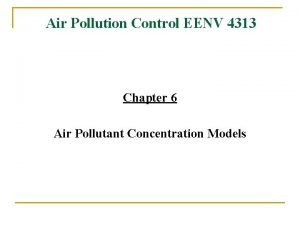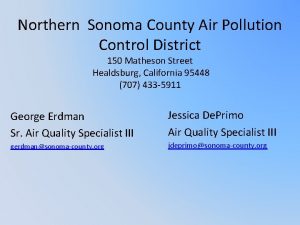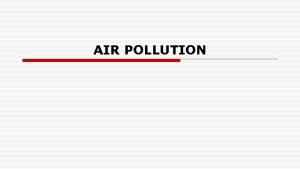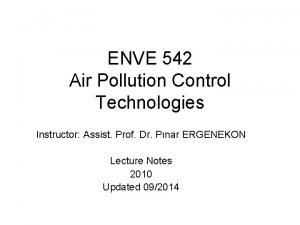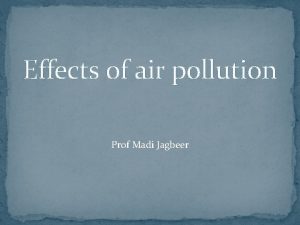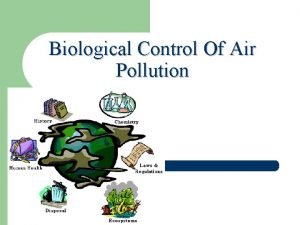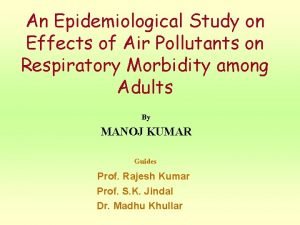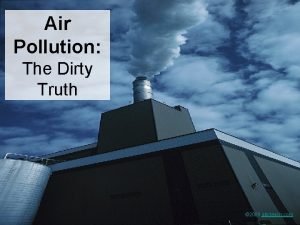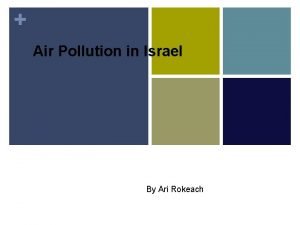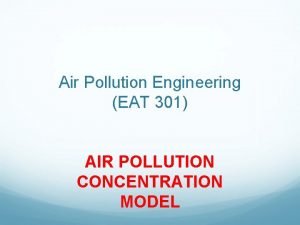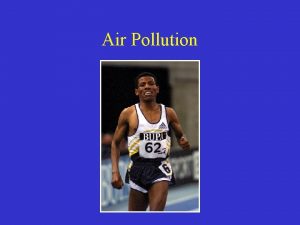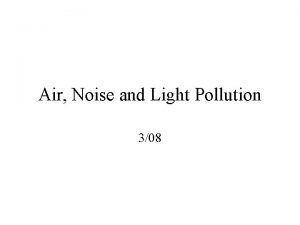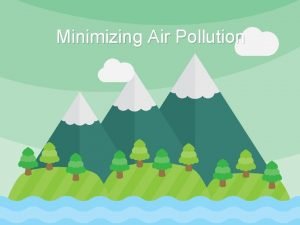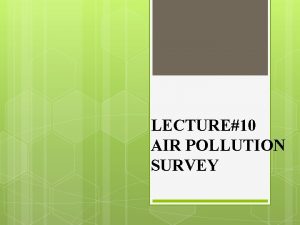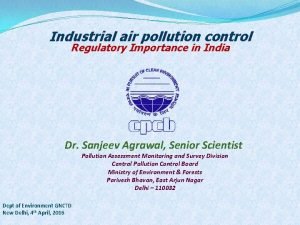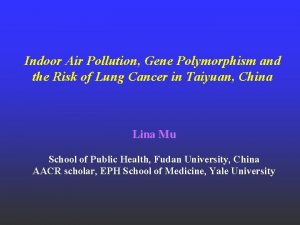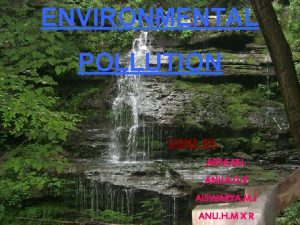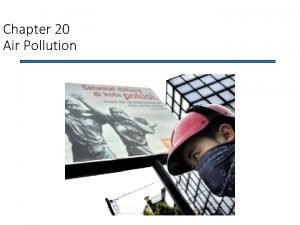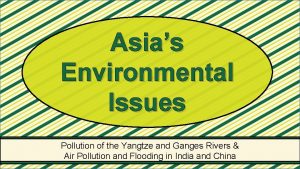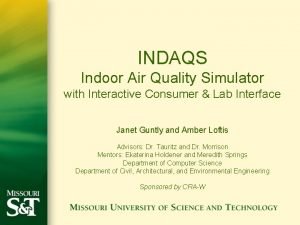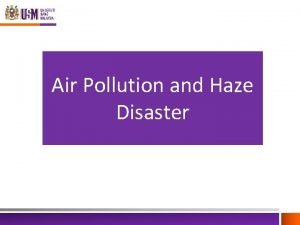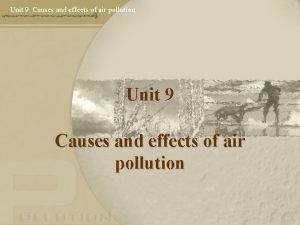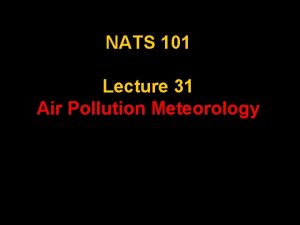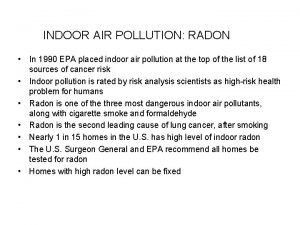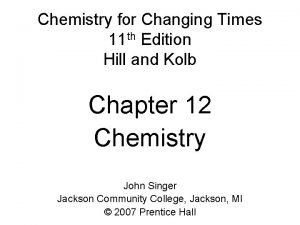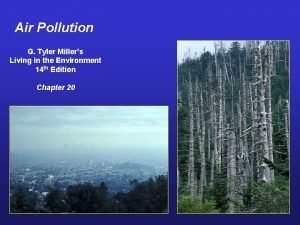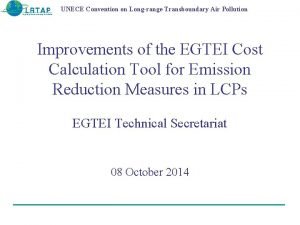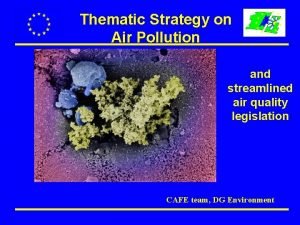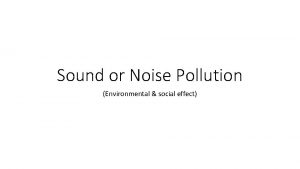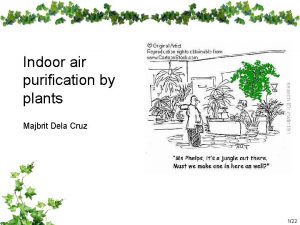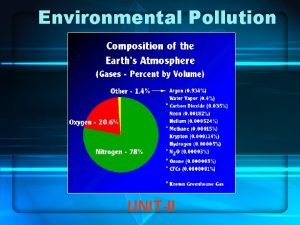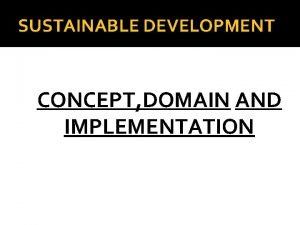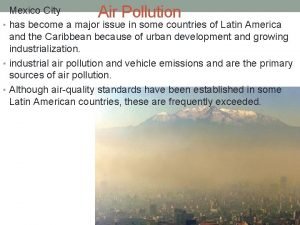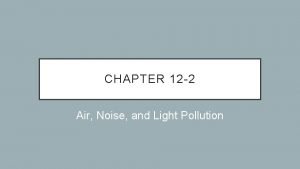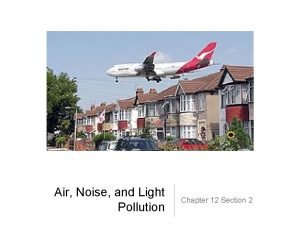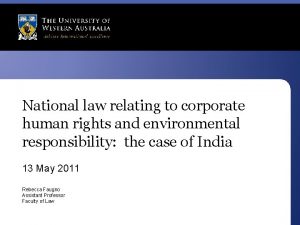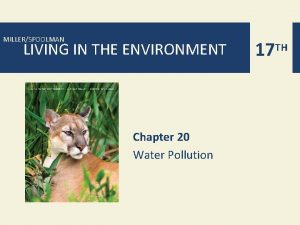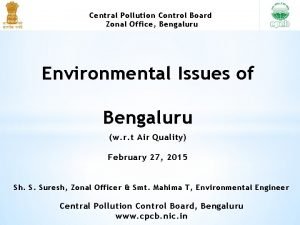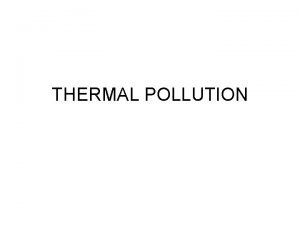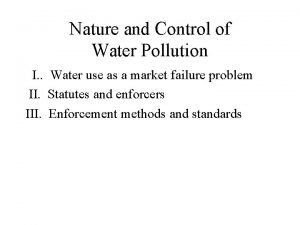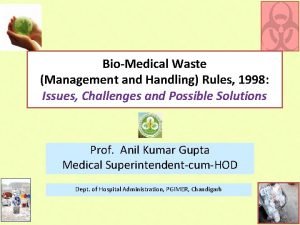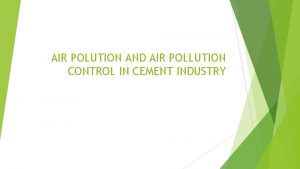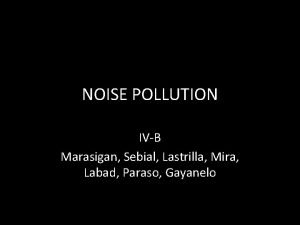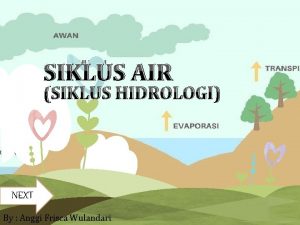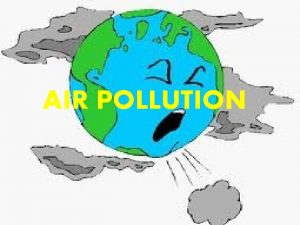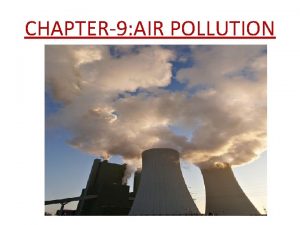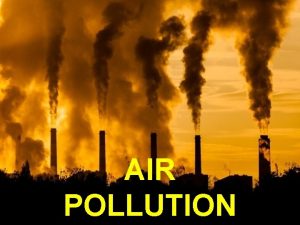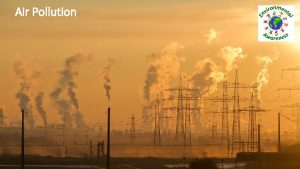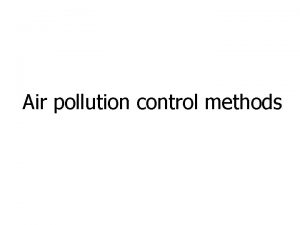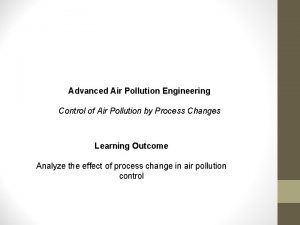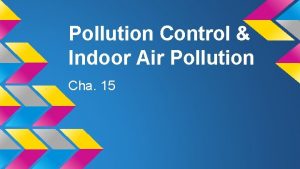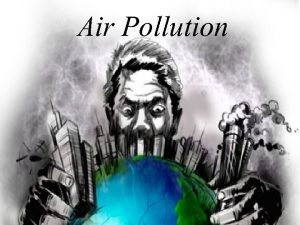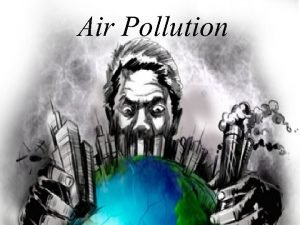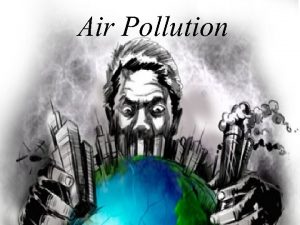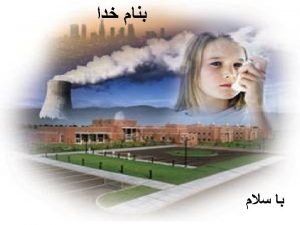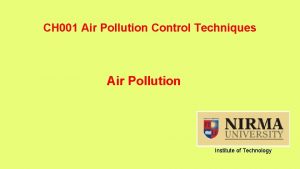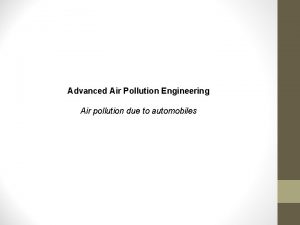Air Pollution Control Engineering Prof Jiakuan Yang Huazhong




































































- Slides: 68

Air Pollution Control Engineering Prof. Jiakuan Yang Huazhong University of Science and Technology

Lecture 9 -2 Control of Primary Particulates Ⅰ Types of Particles collection devices Ⅱ Surface Filter Ⅲ Depth Filter Ⅳ Scrubbers for particulate control Ⅴ Summary

Ⅰ Types of Particles collection devices gravity settlers (重力沉降式室) wall collection device (壁式收集设备) cyclone separator (旋风除尘器) electrostatic precipitators (静电除尘器)



Ⅰ Types of Particles collection devices surface filter (表面式过滤器) dividing collection device (分离式收集设备) depth filter (纵深式过滤器) scrubber (气体洗涤器)





The general idea of Dividing collection devices ① Dividing the dirty gas flow into small parts. ② In small parts, the particles contact filters or water drops and then be collected. ③ The dirty filters are cleaned, or the dirty filters and water are thrown away, or separated.

Ⅱ Surface Filter (1) Particles collecting process by the surface filter Particles which cause significant air pollution are in size ranges from 0. 01 to 10 μ. Typical size of the holes in the cloth is more than 100 μ. How does the cloth act as a sieve for smaller particles?

Ⅱ Surface Filter (1) Particles collecting process by the surface filter ① Firstly, large particles are caught on the sides of the holes of a filter. Dirty gas stream Filter cake Cleaned gas flow △x ② Particles increase, the filter cake forms and becomes the real filter. However, the filter medium serves only to support the cake. ③ The filter cake becomes thicker and thicker, the pressure drop increases to some value. At this time, there must be some way of removing the cake of particles that accumulates on the filters. Cleaning operating is very Filter important for bag house. medium

Filter cake


(2) Two typical bag houses shake-deflate bag house (震动反吹清灰袋式除尘器) pulse-jet bag house (脉冲喷吹清灰袋式除尘器)

(2) Two typical bag houses The difference of these two types of bag house Cleaning way shake-deflate Shake + a weak flow of gas in the reverse direction pulse-jet Intermittent jets of compressed air Cleaning operating Bag house is out of service, Bag house is in and dirty gas flow has service, and dirty gas been switched off. flow is inward through the bags.

Page 261, Fig. 9. 5 shakedeflate bag house


LDB 型布袋除尘器 shake-deflate







Page 283 (3) collected efficiency flow rate or Air to cloth ratio Q — volume flow rate A — filter area, A=n×A 0 — filter area of each bag △P — pressure drop μ— viscosity K — permeability, determined by experiment. △x — thick of filter cake or filter medium.

Page 287 (3) collected efficiency Filter cake m — mass of solids removed, which is the collected particles on the surface of filter. t — time C — particle concentration in dirty air η— collected efficiency

Outlet concentration c, g/m 3 Effect of fabric loading and face velocity on collected efficiency 3. 35 m/min 1. 52 m/min 0. 61 m/min 0. 39 m/min 0 Fabric loading ρ △x , g/m 2

Effect of fabric loading and face velocity on collected efficiency Effect of fabric loading 1) At zero fabric loading (new or freshly cleaned cloth), the outlet concentration is high and practically equals to the inlet concentration of about 0. 89 g/m. 2) As the cake builds up, the outlet concentration declines. 3) Finally outlet concentration remains constant, about 0. 001 times the inlet concentration.

Effect of fabric loading 1% particles pass through the will not be collected. pinholes and Pinholes are regions where the cake does not establish properly.

Effect of superficial velocity (vs) If the superficial velocity increases, efficiency falls.

Ⅲ Depth Filter Depth filter is different from surface filter, does not form a filter cake on the surface, but instead collects particles through out the entire body. Examples Filter –tipped cigarettes Family air filter

Page 293 (1) Depth filter model Dirty air with particles direction is from inner to outer. Vy-gas Vrelative=Vy-gas- Vy-particle Fy-drag A Fy-inertial Db, Obstacle or Target Flow of gas and particles around a cylinder

(1) Depth filter model Gas flow must bend to flow around the fiber. Particles tend to continue going straight because the density of particle is much larger than gas, and the inertia of particle will drive particle along the initial direction. How to evaluate the chance of particles impacting the target by inertial mechanism?

Page 293 (2) Inertial Impaction ① ② resisting force (inertial force)

(2) Inertial Impaction ③ In balance

(2) Inertial Impaction

Page 294 (2) Inertial Impaction Separation Number 分离指数 Impaction parameter 碰撞参数 Inertial parameter 惯性参数 惯性碰 撞参数

(2) Inertial Impaction X stokes’ stopping

Page 293 Fig. 9. 18 (2) Inertial Impaction How Ns affects Target efficiency? Target efficiency, ηt Langmuir and Blodgett 0. 01 0. 1 Separation Number,

Target efficiency (ηt) Target efficiency ηt represents the number of particles that actually contact the target, divided by the number that would have contacted it if all particles had moved perfectly straight and none had been drawn around the target by the gas stream.

Target efficiency (ηt) Target Particles in this region may impinge on target

ηt (2) Inertial Impaction Ns ∝ D 2 D Ns 0. 01 0. 1 Ns ∝ 1/△t ηt For large particles Ns is large, so the inertial force is large, and time decrease so much that particles have not enough time to move around the target. Therefore, the target efficiency ηt will increase.

ηt (2) Inertial Impaction 0. 01 0. 1 Ns is from 0. 01 to 0. 1, ηt is low. Ns ∝ D 2 For a very small particle Ns is so small that the particle has practically zero chance of impacting the target. How small particles are collected by the filters?

(3) Diffusion collection mechanism and interception mechanism The small particles pass so close to the target that Brownian motion moves the particles to the target. Target

(3) Diffusion collection mechanism and interception mechanism Freidlander Diffusivity, m 2/s 运动粘度 Page 296 扩散系数 Kinematics viscosity, m 2/s

(3) Diffusion collection mechanism and interception mechanism 动力粘度 运动粘度 μ (kg/m)·s m 2/s 1 cp = 0. 001 (kg/m)·s=0. 001 Pa·s 厘泊

(3) Diffusion collection mechanism and interception mechanism k ___ Boltzmann constant C ___ Cunningham correction factor T ___ temperature μ ___ the viscosity D ___ diameter of the particle

(3) Diffusion collection mechanism and interception mechanism First term Efficiency for diffusion collection ∝ D ηt

(3) Diffusion collection mechanism and interception mechanism Second term Efficiency for interception Interception mechanism means collection by noninertial contact when particles center passes within Db/2 of the target. Page 297 Target

Page 297 Table 9. 3 (4) Comparison of collection mechanisms Impaction and interception Diffusion D ηt ηt V ηt ηt Db ηt ηt

Ⅳ Scrubbers for particulate control The common example of scrubber is rainstorm Many rain drops divide the dirty gas into a lot of small stream. 0. 5 μ (Particles) Most fine particles will adhere to a 50 μ liquid drop if they (Water drops) contact it.

Page 299 Fig. 9. 20 Ⅳ Scrubbers for particulate control (1) Component parts of a scrubber installation Dirty gas Gas-liquid Mixed gas Contactor (scrubber) and liquid Gas-liquid separator (cyclone) Clean gas Dirty liquid Clean liquid Liquid recirculating pump Liquid-solid separator

Ⅳ Scrubbers for particulate control (1) Component parts of a scrubber installation ① Making the water drops and the particles touch each other, the particles will be caught on the drop. ② Gas and liquid separating. ③ particles are separated from water. ④ Clean liquid recirculating

Ⅳ Scrubbers for particulate control (2) The types of scrubbers Crossflow scrubber Liquid flow in Gas flow out Liquid flow out

Ⅳ Scrubbers for particulate control (2) The types of scrubbers Counterflow scrubber QL, in QL, out QG, in

Ⅳ Scrubbers for particulate control (2) The types of scrubbers Co-flow scrubber Gas flow in w flo d i u q Li in Gas flow out Liquid flow out

Ⅳ Scrubbers for particulate control (2) The types of scrubbers Co-flow scrubber Typical downflow venturi scrubbers Page 308, Fig. 9. 26 并流向下文丘里管湿式洗涤塔

Page 308, Fig. 9. 26

旋风水膜脱硫除尘器 Gas out Gas in Lime liquid in liquid out

高效脱硫消烟除尘器 Gas in Lime liquid in liquid out

Ⅴ Summary Filter or target State of filter mechanism Cleaning method Typical equipment D V scrubber Depth filter Surface filter Cloth, glass-filter cloth Active carbon Sand, Glass-filter stationary Water-drop stationary Filter cake pinhole motion Impaction, Diffusion interception shake-deflate pulse-jet Throw away Cigarette filter Bag house η ηt Impaction ηt interception Target adhere Liquid-solid separator Co-flow venturi scrubbe ηt ηt Diffusion

This Lecture and the Next Lecture q This Lecture: v Chapter 9 Page 280~314 q The Next Lecture: v Chapter 10 page 329~382

Exerciser Page 323, 9. 45 2. Please explain the particles collection mechanisms of the surface filter, depth filter and scrubbers.

补充上届考试题 • 3. A typical coal has the following ultimate analysis by weight: H, 6. 0%; C, 60. 0%; N, 1. 4%; S, 1. 6%; O, 7. 5%; ash 9. 6%. It is burned with 20% excess air with humidity 0. 0116 mol/mol dry air, and combustion is complete. The nitrogen is assumed to exit as both N 2 and fuel NO 2. N in the coal is assumed to be completely transformed into fuel NO 2, and N 2 in air is assumed to keep stable. • (1) Determine the volume of combustion gas produced. • (2) Determine SO 2 and NO 2 concentration in combustion gas produced.


DISCUSSION Topics about Air pollution: q Introducing yourself q Interesting news or information about air pollution your having read or heard q Your opinions on this Air Pollution course q Your suggestions for Chinese Air Pollution q Other familiar issues about Air Pollution
 Fixed box model air pollution
Fixed box model air pollution Chapter 12 section 3 acid precipitation
Chapter 12 section 3 acid precipitation Chapter 12 air section 1 what causes air pollution
Chapter 12 air section 1 what causes air pollution Erg (air pollution control) ltd
Erg (air pollution control) ltd Northern sonoma county air pollution control district
Northern sonoma county air pollution control district Air pollution control methods
Air pollution control methods Air pollution control technology
Air pollution control technology Hubungan air tanah dan tanaman
Hubungan air tanah dan tanaman Pelarut protonik
Pelarut protonik Effect on human health of land pollution
Effect on human health of land pollution Definition of pollution in simple words
Definition of pollution in simple words Land water and air pollution
Land water and air pollution Introduction of pollution
Introduction of pollution Effect of air pollution in plants
Effect of air pollution in plants Contents of air pollution
Contents of air pollution Objective of pollution
Objective of pollution Main cause of air pollution
Main cause of air pollution Primary and secondary pollutants
Primary and secondary pollutants Ari rokeach
Ari rokeach Air pollution box model example
Air pollution box model example General effects of air pollution
General effects of air pollution Air pollution consequences
Air pollution consequences Air pollution
Air pollution Objectives of air pollution
Objectives of air pollution Slogans on air pollution
Slogans on air pollution Air pollution
Air pollution What is inorganic pollution
What is inorganic pollution Air pollution intro
Air pollution intro Two sources of air pollution
Two sources of air pollution 5 effects of air pollution
5 effects of air pollution Indoor air pollution examples
Indoor air pollution examples Air pollution simulator
Air pollution simulator Air pollution 2050
Air pollution 2050 Brainpop canada
Brainpop canada Air pollution
Air pollution What is pollution how is it caused
What is pollution how is it caused Air pollution wildfires
Air pollution wildfires Air pollution
Air pollution Radon indoor air pollution
Radon indoor air pollution Air pollution
Air pollution Prevention of indoor air pollution
Prevention of indoor air pollution Air pollution
Air pollution Air pollution wildfires
Air pollution wildfires Air pollution
Air pollution Conclusion of air pollution
Conclusion of air pollution Environmental pollution conclusion
Environmental pollution conclusion Air pollution specialist
Air pollution specialist Thematic strategy on air pollution
Thematic strategy on air pollution Conclusion of pollution
Conclusion of pollution Conclusion of soil pollution
Conclusion of soil pollution Define mobile sources of air pollution
Define mobile sources of air pollution Adjectives for air pollution
Adjectives for air pollution Indoor air pollutants
Indoor air pollutants Baghouse filter diagram
Baghouse filter diagram Aim and objectives of air pollution
Aim and objectives of air pollution Example of environmental sustainability
Example of environmental sustainability Air pollution mexico
Air pollution mexico Section 2 air noise and light pollution
Section 2 air noise and light pollution Section 2 air noise and light pollution
Section 2 air noise and light pollution Central and state pollution control board
Central and state pollution control board Methods to control water pollution
Methods to control water pollution Central and state pollution control board
Central and state pollution control board Thermal pollution control
Thermal pollution control Sources of thermal pollution
Sources of thermal pollution Control measures of water pollution ppt
Control measures of water pollution ppt Cwtf in biomedical waste
Cwtf in biomedical waste Control of pollution
Control of pollution Ways to prevent noise pollution in party at neighborhood
Ways to prevent noise pollution in party at neighborhood Air hujan sanggup menjadi air tanah lantaran proses
Air hujan sanggup menjadi air tanah lantaran proses
